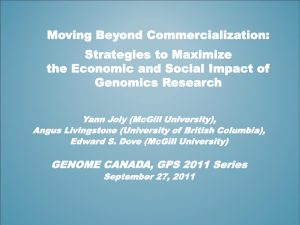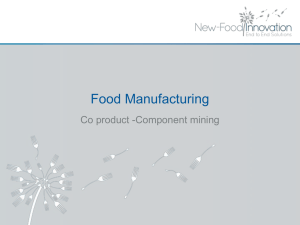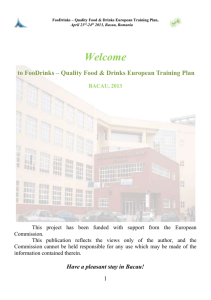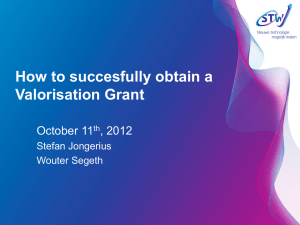Process - WordPress.com
advertisement
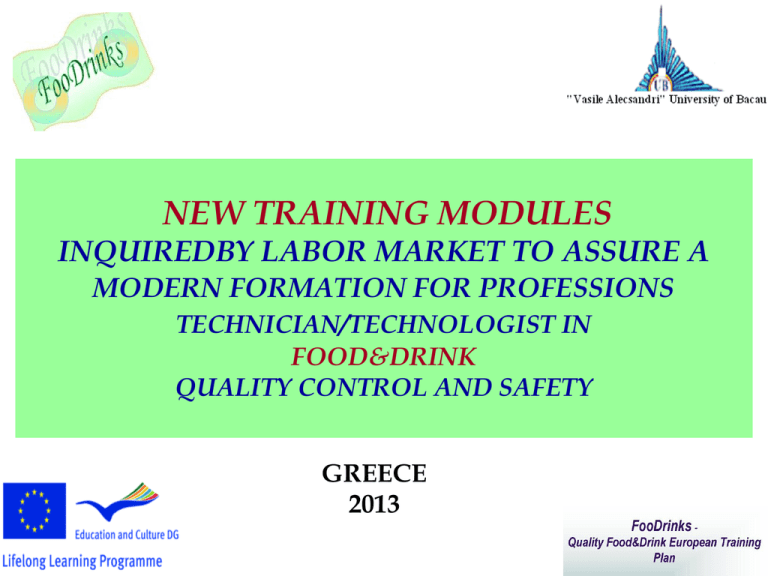
NEW TRAINING MODULES INQUIREDBY LABOR MARKET TO ASSURE A MODERN FORMATION FOR PROFESSIONS TECHNICIAN/TECHNOLOGIST IN FOOD&DRINK QUALITY CONTROL AND SAFETY GREECE 2013 ROMANIA TEAM WORK: Associate Prof.Ph.D.eng. Liliana TOPLICEANU Prof. Ph.D.eng. Luminita BIBIRE Prof. Ph.D.eng. Ileana Denisa NISTOR Prof. Ph.D.chem. Neculai Doru MIRON Lecturer. Ph.D.eng. Vasilica Alisa ARUS PRESENTATION PLAN 1. Presentation of Unit Learnings: - - 2. 3. 1st Module: New sustainabletechnology and production in Food Industry 2nd Module: Practical application rules on the food indutry chain of value Courses description Conclusions Name of the qualification: Technician/technologist in food&drink quality control and safety NQF level 4 EQF Level4 Technical post-secondary training Name of the Unit: 1st Module: New sustainabletechnology and production in Food Industry • Process • Distribution • Energy and water savings • Process efficiency • Green packaging • Byproduct valorization . Name of the Unit: 1st Module: New sustainable technology and production in Food Industry The aim of the Unit is to convey knowledge, in accordance with latest news in scientific and technical fields: Process Discipline contributes to train specialists in quality and food safety; It aims knowing, understanding of concepts, of basic theories and methods of the field and of specialization area, suitable use in professional communication Distribution Discipline provides a set of theoretical and practical knowledge in the field of food distribution, necessary for future specialists in quality control and food safety, in accordance with labor market requirements. Energy and water Discipline built the knowledge and skills of tradespeople and professionals to support improved energy efficiency practices, products and services. Name of the Unit: 1st Module: New sustainable technology and production in Food Industry Process efficiency Discipline offers a set of theoretical and practical knowledge in the field of food process efficiency necessary for a modern trainings of specialists practicing in quality control and food safety. It aims at implementing the most modern methods and techniques to increase the efficiency of the processes in the food industry. Green packaging Descipline provides the basics of green packaging, sustainability and knowledge how to use the recycled packaging materials Byproduct valorization Discipline offers a set of theoretical and practical knowledge in valorization of byproducts technologies from food industry, necessary for future specialists who will access the posts in country and the European labor market. It is aimed the implementation of the most modern methods and techniques of processing by-products of the food industry and obtaining new products Learning outcomes: Knowledge Skills Competence - To identify and to describe the working schemes of different branch of food processing industry - To know the measures which ensure environmental protection; - To indicate the necessary measures for energy and water saving used in food industry - To estimate the appropriate procedures for a high level of process efficiency - To conduct specific activities for technological control on different production stages - To use working techniques and codes of the best practices for food production with innocuity; - To carry out tests to establish indices and technological properties - To monitor the application of measures which ensure environmental protection; - To be able to supervise the food production chain with sustainability; - To be able to plan and calculate the amount of needed materials; - To be able to understand and to resolve technical problems which could appear during the process; - To be able to carry out economic calculation and quality control for food safety; Learning outcomes: Knowledge Skills Competence - To distinguish the best materials the best conditions for green packaging - To explain principles and methods for determining the of raw materials and finished products characteristics for food processing industry - To identify the methods for byproducts valorization - To indicate the suitable measures for storing and distribution conditions of food products - To perform sensory and physical - chemical analysis for raw materials, auxiliaries, finished products and byproducts - To be able to organize the collection, the storing and elimination of wastes; - To be able to organize the recycling of byproducts Name of the qualification: Technician/technologist in food&drink quality control and safety NQF level 4 EQF Level4 Technical post-secondary training Name of the Unit: 2nd Module: Practical Application Rules on the Food Industry Chain of Value • Standard regulations on key issues like packaging (food contact materials), logistics • Implementation of the standards in the food chain • Practical training sessions . Learning outcomes: Knowledge Skills Competence -To know legislation used in food industry; -To identify standards regulations required for the manufacture, store and distribution of food products - To identify irregularities in observance of the legislation - To be concerned about providing appropriate working conditions in production; -To identify the necessary tools and procedures for control of quality and safety processes -To monitor standards implementation in the food chain in accordance to chain traceability; - To implement measures and actions to redress deviations of the standards in force; - To apply the health and work safety and to use individual protection equipment adapted to performed activities; -To be able to comply with and enforce financial and administrative regulations; -To be able to carry out the regulations of the management in accordance with the existing standards; -To be able to understand the operation of special equipments/devices; -To be able to implement the necessary tools and procedures for control of quality and safety processes; Course description (Syllabus) Subject Instructor Contact Term ECTS Points The aim of the course Competences Course description Course requirements Text, readings, materials used Grading method ROMANIA 1st MODULE HUNGARY 1st MODULE Process Energy and water savings Distribution of food products Green packing Process efficiency Byproduct valorization 2nd MODULE Practical training sessions 2nd MODULE Standard regulations on key issues like packaging (food contact materials), logistics Implementation of the standards in the food chain Process 1. The aim of the course Discipline contributes to train specialists in quality and food safety. It aims knowing, understanding of concepts, of basic theories and methods of the field and of specialization area, suitable use in professional communication. 2. Competences • • • • • • She/he is able to: supervise the food production chain with sustainability; plan and calculate the amount of needed materials; understand and to resolve technical problems which could appear during the process; carry out economic calculation and quality control for food safety; organize the collection, the storing and elimination of wastes; organize the recycling of byproducts Process 3. Course description Technological process represents all the mechanical, physical, chemical operations, that by simultaneous or successive action transforms raw materials into goods. The manufacturing process represents all the processes used to transform raw materials and semi-products into finished products. Food industry, studies the technological processes by which vegetable and animal raw materials are transformed into foods, that are finished products of food industry. Process 1. Technological process, technology. Process (evolution in time and / or space of a given system); Technology (all knowledge of the processes and means used to achieve a production in an organized and rational way); Technological process (steps performed by raw materials until processing them into finished products); 2. Technological flow, technological scheme. Technological flow; Technological block scheme; Conventional symbols; Technological plan; Technological installation. 3. Unit Operations Concept unit operation; Technological process - unit operations; Main phenomenon (basic) - unit operation; Dimensional analysis, international measurement system. 4. Mechanical operations Storage and transport of solid materials; Batching of granular materials; Milling of solids; Classing (screening). Process 5. 6. Hydrodynamical operation (momentum transfer). Transport of liquids; Ccompression and transport of gases; Mixing (stirring); Sedimentation; Filtration; Centrifugation Thermal operations (heat transfer). Heating and cooling; Boiling and condensation; Distillation and rectification. 7. Diffusion operations transfer) Absorption; Adsorption; Extraction. (mass 8. Chemical and biochemical process The mechanism of the process; Composition of the mass reaction; The degree of transformation; Primary equations for material balance. Process 9. Driving force of process chemistry and biochemistry manufacturing / key stage determined by the speed of the process Equilibrium process; Reaction kinetics; Procedures for activating chemical and biochemical reactions; Catalysis and catalysts; Technological enzymology enzymatic catalysis. 10.Equipments for structural changes Biochemical reactor, bioreactor; Types of bioreactors, 4. Course requirements Basic knowledge in the field of food industry. Process 5. Text, readings, materials used The lecture using modern tools such as video projection and rear projection of images, explanation, debate, study of curriculum documents and bibliography. 6. Grading method Minimum conditions for promotion (5 note) Conditions for obtaining maximum note (10 note) Active presence to lecture and laboratory – 20% Evaluation of the laboratory activity – 20% Answers to exam – 60% Active presence to lecture and laboratory – 10% Evaluation of the laboratory activity – 20% Answers to exam – 70% Distribution of food products 1. The aim of the course Discipline provides a set of theoretical and practical knowledge in the field of food distribution, necessary for future specialists in quality control and food safety, in accordance with labor market requirements. 2. Competence She/he/ be able/ to: to be able to supervise the food production chain with sustainability; to be able to plan and calculate the amount of needed materials; to be able to carry out economic calculation and quality control for food safety. Distribution of food products 3. Course description Food distribution is the circuit that food products go to reach from the production stage to the consumption stage. In the food distribution should not be ignored the aspects of packaging, storage and preservation of food per unit production, suitable transport conditions according to the product transported, as well as by creating the storage conditions to beneficiary. Another aspect that is part of the food distribution is related to accompanying documents (documents that certify the quality and accounting and financial documents) Distribution of food products 1. Complex content of distribution 2. Food packaging Packaging material used, according to the nature of food product; Interaction package- product; Package toxicity; Mathematical models used in packaging for package saving; Package design. 3. Preservation / storage of finished food products Preservation techniques applied finished food products; Food storage, ensuring conditions and spaces according to specifics of products and European legislation. 4. Food transport Ensuring transport conditions according to the nature of food product 5. The storage to beneficiary Ensuring suitable conditions in storages and shops 6. Functions and costs of food distribution. Advantages of specialized distribution. 7. Distribution circuits Circuits types Choice of distribution channels Systems and food distribution channels Distribution of food products 1. Food market launch Market launch forms used by food manufacturers 2. Food markets The social and economic role of food markets Food markets types Production markets Wholesale markets Food produce exchanges 1. Wholesale and retail distribution of food products Wholesale trade of food products Retail trade of food products 11.The reform of food distribution system in Romania and the European Union 4. Course requirements Basic knowledge in the field of food industry. 5. Text, readings, materials used The lecture using modern tools such as video projection and rear projection of images, explanation, debate, study of curriculum documents and bibliography 6. Grading method Process efficiency 1. The aim of the course Discipline offers a set of theoretical and practical knowledge in the field of food process efficiency necessary for a modern trainings of specialists practicing in quality control and food safety. It aims at implementing the most modern methods and techniques to increase the efficiency of the processes in the food industry. 2. Competence He/she is able to: supervise the food production chain with sustainability; plan and calculate the amount of needed materials; carry out economic calculation and quality control for food safety; organize the collection, the storing and elimination of wastes; Process efficiency 3. Course description Increasing the efficiency of the chemical and biochemical processes, results from a necessity because food processes have to satisfy the growing demands of quality, of saving raw materials, energy and respect for our environment. 1. Fundamental notions of biochemical process. The notion of biochemical process; The notion of a unitary process and technological process; 2. Relationship process equipment in food technology Technological phase / equipment; Main technological stage / main equipment; 3. Manufacturing processes of the raw materials in the food industry. Physical processing (mechanical processing, heat treatment, radiation processing); Chemical processing (chemical sterilization, fermentation, chemical processing); Physico-chemical processes of mass transfer, heat transfer , momentum transfer, mixt transfer); Process efficiency 4. Increasing the processes efficiency in the food industry using new technologies without obsolescence. 5. Increasing the processes efficiency in the food by processing of byproducts. 6. Increasing the processes efficiency in the food industry using methods and intensification technology by fluidized bed. Principle of fluidized bed; Specific equipment to intensify the processes using fluidized bed; Using of fluidized bed in food processes; Intensification of dry processes using fluidised bed. 7. Increasing the processes efficiency in the food industry using ultrasound intensification. General notions on ultrasound; Using of ultrasound in food processes. 8. Increasing the processes efficiency in the food industry using microwave processing. General notions on microwaves; Using of microwaves in food processes. 9. Increasing the processes efficiency in the food industry using athermal minimal processing. Relationship temperaturethermal degradation of some raw materials and finished food products; Application of athermal processes in the food industry and processing efficiency Process efficiency 10.Increasing the processes efficiency in the food industry using high pressures processing. Relationship pressure- conversion of raw materials to finished products; Application of high pressures processing in the food industry. 4. 11.Increasing the processes efficiency in the food industry using supercritical fluid processing. Notion of supercritical fluid, properties; Application supercritical fluid processing in food industry (oil extractions). Course requirements Basic knowledge in the field of food industry. 5. Text, readings, materials used The lecture using modern tools such as video projection and rear projection of images, explanation, debate, study of curriculum documents and bibliography 6. Grading method Byproduct valorization 1. The aim of the course Discipline offers a set of theoretical and practical knowledge in valorization of byproducts technologies from food industry, necessary for future specialists who will access the posts in country and the European labor market. It is aimed the implementation of the most modern methods and techniques of processing by-products of the food industry and obtaining new products. 2. Competence She/he/ be able/ to: To be able to supervise the food production chain with sustainability; To be able to understand and to resolve technical problems which could appear during the process; To be able to carry out economic calculation and quality control for food safety; To be able to organize the collection, the storing and elimination of wastes; To be able to organize the recycling of byproducts Byproduct valorization 3. Course description Realization of bio-products from different food byproducts is a priority in improving processes having an high impact to enhance quality of life. By-products from the food industry due to the high content in active ingredients is a rich raw material for making other biological products of interest for food, industrial, pharmaceutical, livestock and agricultural field. 1. Valorisation of byproducts from milling and bakery industry Valorisation of bran in bakery industry; Valorisation of bran for fodder purposes; Valorisation of byproducts to obtain the wheat germs; Valorisation of byproducts in order to obtain starch; Valorisation of byproducts in order to obtain alcohol. Byproduct valorization 2. Valorization of byproducts from dairy industry Valorization of byproducts from dairy industry to obtain protein concentrates Obtaining the whey protein concentrate Valorization of byproducts from dairy industry to obtain casein and caseinates Valorization of byproducts from dairy industry to obtain lactose, in order to obtain products that mimic breast milk, preparing food products for diabetics, additives in fruit juices and vegetable powder, to obtain chewing gums, support for antibiotics or other drugs, ingredient in the composition of fermentation mediums in antibiotics industry, to obtain whey biomass used in bakery, meat industry, to obtain food for children, getting flavoring products, etc. Valorization of whey for obtaining metabolite from fermentation of whey: alcohol, acetic acid, vitamin B12, vitamin B2, etc. Valorization of buttermilk to obtain fermented buttermilk powder used in soft drinks, Valorization of buttermilk to obtain sweet buttermilk powder used in baking industry - increasing protein content, making acloride bread. Byproduct valorization 3. Valorization of by-products from beer industry Manufacture of bakery yeast and yeast feed; Valorisation of byproducts and malt flour manufacture; Valorisation of byproducts for the delivery of malt germs; Valorisation of brewers grains with obtaining materials for feeding; Valorisation of byproducts by making fertilizer products. 4. Valorization of by-products from fermentation industry Valorization of grape marc and making products with different alcoholic; Valorization of grape bunches by obtaining metabolites, tartaric acid, etc; Valorization of wine yeast to obtain metabolites, protein and vitamine preparations for animals; Valorization of waste from wine industry for production of tannins; Valorization of waste and production of special products, antioxidants; Valorization of waste in livestock and / or agriculture. Byproduct valorization 5. Valorization of by-products from meat industry Valorization of raw skins; Valorization of ferments and endocrine glands to be sent in pharmaceutical processing centers in order to obtain some metabolites such as growth hormones; Valorization of horny material by manufacturing household or handicraft products;; Valorization of bones and horny material by manufacturing glues; Valorization of blood by stabilization technologies, defibrillation, separation and preservation; Valorization of blood for obtaining food and technical supply albumin. 6. Valorization of by-products from the fish industry Valorization of fish liver by obtaining medicinal oil; Valorization of by-products from the fish industry to obtain protein hydrolysates; Valorization of by-products for obtaining flour and fish oil; Valorization of by-products for obtaining of fish glue. Byproduct valorization 7. Valorization of by-products from the processing of fruits and vegetables. Valorisation of by-products to obtain pectin, then used in the food industry; Valorisation of by-products by making gelled products; Valorisation of seeds and obtaining of oils; Valorisation of by-products by obtaining distillate alcoholic products; Valorisation of by-products and using for feed; Valorisation of by-products for production of natural colorants. 8. Valorization of by-products from sugar industry Valorisation of beet pulp in order to obtain metabolites and use for feed Valorisation of molasses in order to obtain alcohol; Valorisation of by-products by manufacture of glucose, fructose, dextrin and dextrose; Valorisation of spent sugar- beet pulp, to obtain acid hydrolysis for fodder yeast; 9. Valorization of by-products from vegetable oil industry Valorisation of grist (of cakes resulted after extraction by pressing oil); Valorisation of waste and obtaining lecithin; Valorisation of shell oilseeds in order to obtain fuel materials; Valorisation of by-products for the production of biofuels. Byproduct valorization 4. Course requirements Basic knowledge in the field of food industry. 5. Text, readings, materials used The lecture using modern tools such as video projection and rear projection of images, explanation, debate, study of curriculum documents and bibliography 6. Grading method Practical training sessions 1. The aim of the course Through practical activity aims to: familiarize students with the companies of chemical and biochemical profile, identifying links between theoretical and practical knowledge introduction to the complex issues of their activities, to develop intellectual skills: independent study, making a practical, portfolio, to develop communication skills and orientation in real space of a company profile, forming critical-reflective thinking, to stimulate the expression and argumenting of personal views concerning the practical reality. 2. Competence He/she can/tests to: To be able to comply with and enforce financial and administrative regulations; To be able to carry out the regulations of the management in accordance with the existing standards; To be able to understand the operation of special equipments/devices; To be able to implement the necessary tools and procedures for control of quality and safety processes; Practical training sessions 3. Course description 1. Performing of briefing on the rules of Safety and Health at Work; 2. Company organization; 3. Technological organization of production sections to achieve finished products specific establishment; 4. Students will study will follow together with qualified persons the installation and technology flows to registration under normal working parameters, will contribute to the notification causes deviations from technological regimes and how to remove them; 5. Students will follow together with qualified personsl the control of parameters of technological phases, will record the measurement and control equipment, and how and efficiency in the good functioning of the equipment, section, technological process; Practical training sessions 6. Students must prepare practice notebooks that will include: company presentation, organization of society, technological process description, process flow diagram, the main processes occurring and major operations, eg. physicochemical processes, processes of extraction, separation, purification, concentration (rectification where necessary), special heat treatments (eg. heating or cooling), biochemical processes, microbiological and biochemical implications on product, analysis methods and flow control; 7. Will be pursued processes, guarantee period; 8. Will be pursued concepts regarding quality assurance of products; 9. It will be pursued closely the laboratory activities for control of raw materials, intermediate products of the technological manufacturing, of finished products, allowing execution of tests with a high degree of accuracy; 10.Students will perform additional documentation for modernized processes, especially when there are in units new technological phase (to improve quality and cost price declines). Practical training sessions 4. Course requirements Basic knowledge in the field of food industry. 5. Text, readings, materials used Activity of technological practice in an enterprise of profile. 6. Grading method Practical work no 1. Valorisation of bran. Obtaining of bread with the addition of bran Principle of the method This paper aims to study the influence of parameters on the characteristics of bread with bran. Equipment necessary - Mixer Bakery - Oven with fermenting Method of work Bread is prepared based on technological scheme shown in Fig. 1. Prepare dough recipe is as in Table 1. Fig. 1. Techological scheme for obtaining of bread with the addition of bran During the fermentation process, the pieces will be subjected to the following tests: Titratable acidity; pH; Temperature; volume; Elasticity. Results will be listed in Table 2. Analisys bread Cut bread in half and make the following analysis: – Organoleptic examination; – Porosity; – Acidity of the shell; – Acidity of core; – Elasticity of core; – Humidity. Bread is let to aging and allow to repeat analysis. The results are recorded in Table 3. Experimental results will represent graphically (toatete recipes on the same graph) and will interpret the results. Practical work no 2. Valorization of whey. Obtaining cheese whey Valorization of whey. General aspects Whey is the aqueous fraction resulting from curdled milk and curd obtained filtration. This phase is a byproduct of cheese manufacturing technology but can be recovered due to its high nutritional value. The ways of whey valorization are multiple and depend largely on its chemical composition and the supply-demand ratio of each component of whey (Fig. 1). Modern processes of valorization of whey perform the fractionation of dry substance by separating proteins by various methods (precipitation, ultrafiltration, gel filtration) or demineralization (ion exchange or electrodialysis). Cheeses obtained from whey are high content in protein, minerals, vitamins and variable proportions of lactose and fat. Fig. 1 Methods for valorization of whey Method of work In this paper will be pursued organoleptic properties and cheese technology with whey as raw material. It is necessary to do the whey acidity determination. Initial part of the whey used in the manufacturing of cheese is treated for a slight decrease of pH. Acid modification can be made by adding lactic acid or aspirin, leaving then a time of 30 minutes to rest. The sour whey is added on sweet whey and after is boiled, for coagulation of serum proteins. Curd obtained is collected in a piece of cheesecloth, leaving it to drain to remove excess mass of whey from cheese mass and obtaining adequate moisture. Will be analyzed along of drainage phase the organoleptic properties, conducted a comparative study on the different degrees of humidity of the product obtained. Expression of results Taking into account that it will achieve three determinations (maximum moisture, minimum and average) results are expressed as: Notes given will have the following values: 1. very good; 2. good; 3. satisfactory; 4. unsatisfactory; 5. total improperly. GREECE 2013
